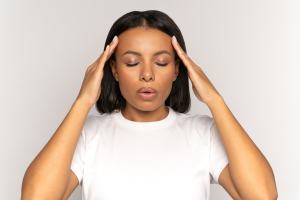Anxiety is a protective emotion, meant to warn you about perceived danger or harm. For most, it’s an occasional feeling, one that will come and go in moments. However, for others, anxiety takes up a large amount of their emotional energy, causing more harm than good. This is where routine anxiety differs from an anxiety disorder.
According to the American Psychiatric Association, anxiety disorders now affect 30% of adults at some point in their life. There are a number of different anxiety disorders, some of which cause panic attacks, rapid heartbeat, or a variety of other symptoms.
If you believe you may have an anxiety disorder, here are some common symptoms, a list of the different disorders, and treatment options to consider speaking to a health professional about.

What Is Anxiety?
An anxiety disorder is a mental health condition that causes intense fear, worry, or nervousness to an excessive degree and for extended periods of time. Anxiety disorder symptoms often get in the way of living your life as you normally would, making you want to avoid places or situations that could trigger your anxiety.
Is Anxiety a Mental Illness?
Feeling anxiety is not a mental illness—it’s a normal emotion that can happen to anyone at any point in their life. However, anxiety is different when it becomes chronic and/or debilitating. So, yes, anxiety can be a mental health disorder depending on its frequency and intensity.
What Are 10 Signs and Symptoms of Anxiety Disorders?
There are many signs to look for if you think you or someone you love might have a problem with anxiety. However, there are 10 common anxiety disorder symptoms:
- Feeling nervous or restless
- Having a sense of impending doom; feelings of uneasiness or fear; or feeling out of control
- Panic attacks
- Increased heart rate, heart palpitations
- Hyperventilation, shortness of breath
- Sweating, blushing, trembling, or tingling, often in the hands or feet
- Feeling weak or tired
- Trouble concentrating or focusing on anything aside from the present worry
- Trouble sleeping
- Stomachaches, nausea
Some of these signs are more common in specific disorders than they are in others, but if you experience a number of these symptoms regularly and intensely, it could be a sign of a larger issue like an anxiety disorder.
However, before you proceed with any kind of treatment, it’s probably best that you speak with a doctor about your symptoms, as they could stem from an issue besides an anxiety disorder. Whether it’s an anxiety disorder or not, your doctor should be able to suss out what’s causing your anxiety and will either suggest what anxiety treatment would be best or refer you to a mental health professional who can.
What Are the 9 Major Types of Anxiety Disorders?
- Generalized anxiety disorder (GAD): Excessive, unrealistic distress or anxiety about ordinary or common events and happenings, even ordinary, routine issues, often feeling worry disproportionate to the situation. It can also be difficult to control or to set aside a worry. This is a common symptom of many anxiety disorders, though it should not be mistaken for everyday worry or stress. People with GAD experience intense amounts of anxiety over an extended period of time.
- Panic disorder: Experiencing sudden bouts of extreme fear or terror that escalate into panic attacks. You’ll be overcome by many intense physical sensations, such as rapid breathing, increased heart rate, and/or chest pain. This can lead to a lingering fear of having more panic attacks or attempting to avoid places or environments that might trigger one. Panic attacks are a symptom of panic disorder, but having these attacks does not mean that you have panic disorder.
- Social anxiety disorder: Having a persistent and intense feeling that you’re being watched and judged by others in social situations. Feelings of self-consciousness, fear, and unease that cause an avoidance of social settings. Also known as social phobia.
- Agoraphobia: Fear of places that feel crowded or hard to escape, causing you to avoid places that make you feel trapped or helpless. This can happen in open or closed spaces, such as public transportation, lines, or crowds.
- Specific phobias: Anxiety pertaining to fear of a specific object or situation. Exposure to these items or scenarios causes anxiety and can lead to panic attacks in some cases. Examples of phobias included flying, needles/injections, or heights.
- Separation anxiety: Experiencing extreme fear or worry when people leave your sight or when you’re separated from them. This results in reluctance or refusal to leave that person or spend days/nights away, which can affect day-to-day function. Though this is normally seen in children, adults can also be diagnosed with this disorder.
- Selective mutism: A type of anxiety mainly seen in children, it makes it difficult to speak to others in public places like school, even if they talk at home.
- Substance-induced anxiety disorder: Panic or anxiety that occurs due to substance use, such as misusing drugs, taking medications, exposure to toxic substances, or drug withdrawal.
- Anxiety disorder due to a medical condition: Intense fear or anxiety that is directly related to a physical health problem and impairs one’s social or occupational functioning.
Though conditions like obsessive compulsive disorder (OCD) and post-traumatic stress disorder (PTSD) are similar to anxiety disorders, they are not technically considered to be.
Hello, we're here to help you
We provide award-winning mental health services nationwide, with flexible scheduling & insurance coverage. Start your journey this week.
What Are the Top 4 Anxiety Disorders?
The most common anxiety disorders are specific phobias. According to the American Psychiatric Association, up to 12% of adults in the U.S. are diagnosed with specific phobias every year. Coming in under specific phobias in second place is social anxiety disorder, with 7% of adults getting diagnosed every year.
Up to 3% of U.S. adults are diagnosed with panic disorder per year, and 2% find that they have GAD.
What Are the Risk Factors for Developing an Anxiety Disorder?
The exact causes of anxiety are unknown. However, in general, these disorders seem to stem from both genetic and environmental factors. Anxiety can be an inherited trait, but environmental stressors can also cause the disorders to manifest. Anxiety disorders are also more commonly seen in women than men.
These risk factors might show up as a child being shy or nervous in new situations, or having exposure to a traumatic event or stressful environment. Symptoms can also be exacerbated by thyroid problems, heart arrhythmia, or use of substances like caffeine or medication.
What Are the Treatment Methods for Different Anxiety Disorders?
Sadly, many people never seek anxiety treatment, often because they don’t realize they have anxiety or they don’t know that anxiety is treatable. But when they do, therapy, medication, and other interventions prove successful.
Psychotherapy
The most common anxiety disorder treatment option is psychotherapy, also known as talk therapy. This is a very standard form of therapy, but what makes it effective against anxiety is the targeting of specific anxieties and working to overcome them. If the therapeutic approach is too generalized, it may not work as well.
There are two main types of psychotherapy used to help with anxiety: cognitive behavioral therapy (CBT) and acceptance and commitment therapy (ACT).
Cognitive behavioral therapy is a type of psychotherapy that’s helpful for restructuring thinking and behavioral patterns. Through CBT, you can learn to discern the thought patterns you have that lead to your worry and anxious feelings, then learn to change them and react to things differently over time.
One CBT technique is exposure therapy, which involves confronting your fears and worries head-on by participating in specific activities that you would try to avoid. This is especially helpful when dealing with phobias or obsessive compulsive disorder (OCD).
The next most common psychotherapy strategy for anxiety is acceptance and commitment therapy.
Instead of trying to change the way you think about things, it’s more about accepting all your thoughts and being able to sort through them mindfully. In ACT, there are no “bad thoughts.” It teaches you how to live with both unpleasant and pleasant thoughts, as they are both a fact of life.
This approach is most helpful to those who have trouble facing life’s hardships and problems directly, preferring to shove down feelings and thoughts they would rather avoid. By learning to live with difficult feelings and letting them exist alongside good feelings and thoughts, it gives them space to process what they’re feeling and face their anxiety.
Medication
Medication is another common treatment for anxiety disorders. Though medications will not cure your anxiety, they can lessen the severity of your symptoms, allowing you to move through your life a bit easier.
If you’re considering asking a professional about starting medication for your anxiety or they recommend it, keep in mind: You may have to try multiple different medications before finding the right one for you.
It’s also normal to have to increase or decrease your dosage a few times once you find one that works. If you want to stop taking your medication, please seek your provider’s help, as doing so on your own can cause withdrawal symptoms and other issues.
When it comes to prescribed anxiety medication, there are usually three types to choose from. First, there are antidepressants. As the name suggests, they are mainly used to treat depression. However, they can help improve the way chemicals in your brain are used to control mood or stress, thereby relieving some anxiety symptoms.
However, there can be some major side-effects to antidepressants. The first few weeks of taking these medications can be especially risky, as some young people, usually under the age of 25, can experience an increase in suicidal thoughts or behavior.
There are also anti-anxiety medications that deal specifically with symptoms of anxiety. Anti-anxiety meds called benzodiazepines are used most frequently, but there can be some major drawbacks.
Most providers only prescribe benzodiazepines for short periods of time, as some patients build up a tolerance to the medication or even become dependent on it. However, they also take effect faster than antidepressants and are more targeted, meaning they can be more reliably effective.
Though the side effects of taking antidepressants or anti-anxiety meds do not happen to everyone, it’s best to work closely with your provider while on anxiety medications to be safe and make sure you’re getting the most out of your care.
Finally, there are beta-blockers. These aren’t used as regularly to treat anxiety, and their main purpose is to treat heart conditions such as high blood pressure. Even so, they can be useful in preventing physical anxiety symptoms like shaking or racing heartbeat. Some take these as needed to stave off predictable forms of performance anxiety or other acute forms of anxiety.
Stress Management Techniques
There are many stress management techniques that one can implement to help with anxiety. Often, these techniques are used alongside psychotherapy to help enhance its results.
Most stress management works to quiet or still your mind in one form or another. One helpful method is exercise. If you prefer a less physically demanding tactic, mindfulness and meditation can also help reduce your symptoms.
Support Groups
Support groups can be a great way to find connection and understanding. Anxiety disorders are a widespread issue which many people face. It can be comforting to know that you are not alone in what you face, and it can be beneficial to hear how other people are coping with their anxiety and how well it works for them.
However, support groups are no replacement for anxiety treatments like psychotherapy or medication. If you are interested in something advised by a support group member, it’s a good idea to consult a doctor before taking action to make sure this is the right treatment for you.
Whatever you decide to do to treat your anxiety, it’s important to follow an anxiety disorder treatment plan that caters to your specific needs and is right for you. Your provider or care team will work closely with you to develop a treatment plan that helps you manage your specific symptoms and disorder.













